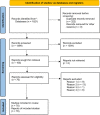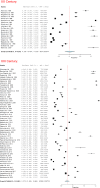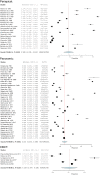Prevalence of root canal treatment worldwide: A systematic review and meta-analysis
- PMID: 36016509
- PMCID: PMC9826350
- DOI: 10.1111/iej.13822
Prevalence of root canal treatment worldwide: A systematic review and meta-analysis
Abstract
Background: The prevalence of root filled teeth (RFT) worldwide will inform about the amount of clinical activity of dentists dedicated to treat endodontic disease.
Objectives: To carry out a systematic review with meta-analysis answering the following question: What is the prevalence of RFT around the world? The percentage of people with at least one RFT was also investigated.
Methods: A systematic review including population-based studies using the following databases: PubMed, EMBASE and Scielo. Studies related to prevalence of RFT were included. The outcome of interest of the study was the prevalence of RFT. The meta-analyses were calculated with the Open Meta Analyst software to determine the global prevalence of RFT. Subgroups analyses were performed comparing geographical distribution, radiographic method and year of the study (classified in 20th or 21th century). The prevalence of people with at least one RFT was also analysed.
Results: Seventy-four population-based studies fulfilled the inclusion criteria. Twenty-eight, forty-four and two studies reported high, moderate and low risk of bias, respectively. No obvious publication bias was observed. Prevalence of RFT was estimated with 1 201 255 teeth and 32 162 patients. The calculated worldwide prevalence of RFT was 8.2% (95% CI = 7.3%-9.1%; p < .001). The global prevalence of people with at least one RFT was 55.7% (95% CI = 49.6%-61.8%; p < .001). In 20th century, the prevalence of RFT was 10.2% (95% CI = 7.9%-12.5%; p < .001), whereas in the 21st century the overall calculated prevalence of RFT was 7.5% (95% CI = 6.5%-8.6%; p < .001). Brazilian people (12%) and the European population (9.3%) showed the highest prevalence of RFT. In Europe, 59.6% (95% CI = 52.4%-66.8%) of people has at least one RFT.
Conclusions: This review showed that root canal treatment is a very common therapy throughout the world. More than half of the studied population have at least one RFT. A limitation of the present study is that most of the studies did not consider random sampling for population selection.
Registration: PROSPERO Systematic review registration number: (CRD42022329053).
Keywords: epidemiology; population-based study; prevalence; root canal treatment; root filled teeth; survey.
© 2022 The Authors. International Endodontic Journal published by John Wiley & Sons Ltd on behalf of British Endodontic Society.
Conflict of interest statement
The authors declare no conflict of interest.
Figures






References
-
- Ainamo, A. , Soikkonen, K. , Wolf, J. , Siukosaari, P. , Erkinjuntti, T. , Tilvis, R. et al. (1994) Dental radiographic findings in the elderly in Helsinki, Finland. Acta Odontologica Scandinavica, 52, 243–249. - PubMed
-
- Akachi, Y. & Canning, D. (2015) Inferring the economic standard of living and health from cohort height: evidence from modern populations in developing countries. Economics and Human Biology, 19, 114–128. - PubMed
-
- Allard, U. & Palmqvist, S. (1986) A radiographic survey of periapical conditions in elderly people in a Swedish county population. Dental Traumatology, 2, 103–108. - PubMed
-
- Al‐Omari, M.A. , Hazaa, A. & Haddad, F. (2011) Frequency and distribution of root filled teeth and apical periodontitis in a Jordanian subpopulation. Oral Surgery, Oral Medicine, Oral Pathology, Oral Radiology and Endodontology, 111, e59–e65. - PubMed
Publication types
MeSH terms
LinkOut - more resources
Full Text Sources
Research Materials

